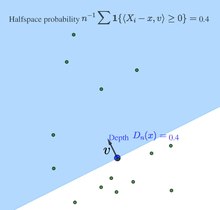|
Tukey depth
In statistics and computational geometry, the Tukey depth [1] is a measure of the depth of a point in a fixed set of points. The concept is named after its inventor, John Tukey. Given a set of n points in d-dimensional space, Tukey's depth of a point x is the smallest fraction (or number) of points in any closed halfspace that contains x. Tukey's depth measures how extreme a point is with respect to a point cloud. It is used to define the bagplot, a bivariate generalization of the boxplot. For example, for any extreme point of the convex hull there is always a (closed) halfspace that contains only that point, and hence its Tukey depth as a fraction is 1/n. Definitions Sample Tukey's depth of point x, or Tukey's depth of x with respect to the point cloud , is defined as
where is the indicator function that equals 1 if its argument holds true or 0 otherwise. Population Tukey's depth of x wrt to a distribution is
where X is a random variable following distribution .
Tukey mean and relation to centerpointA centerpoint c of a point set of size n is nothing else but a point of Tukey depth of at least n/(d + 1). See alsoReferences
|





